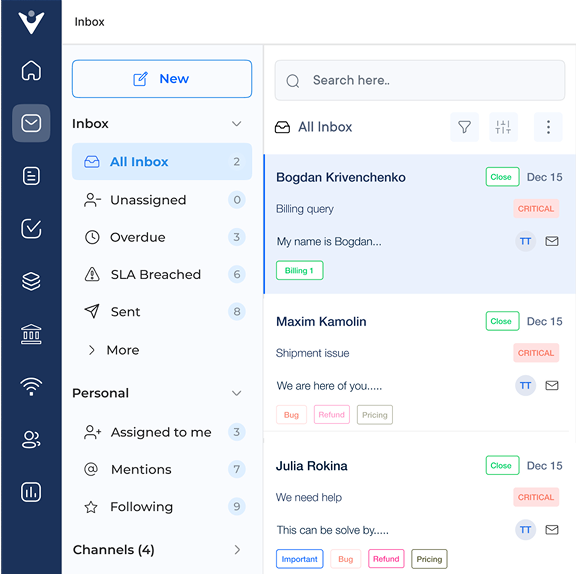Omnichannel support involves delivering accessible self-help resources, such as knowledge base articles, FAQs and chatbots, through various touchpoints, including websites or messaging apps. The approach empowers customers to find solutions independently, reducing the need for direct support interactions.
Things to consider:
- Conduct customer research to identify the channels and platforms most preferred by the target audience for self-service support.
- Ensure consistent branding, messaging and user experience across all self-service channels for a cohesive experience.
- Leverage omnichannel analytics to track customer behavior and optimize self-service resources accordingly.
7. Create Canned Responses
Businesses can ensure consistent and accurate information is provided to customers by developing standardized responses for common issues. It helps in reducing the need for repetitive manual responses from support agents.
Canned responses not only streamline agent workflows by reducing the time spent crafting individual replies but also promote knowledge sharing among the support team. Regularly updating the responses with product updates and best practices ensures their accuracy.
Tips:
- Analyze support data and customer feedback to identify the most frequently asked questions to prioritize canned response creation.
- Integrate canned responses into your support software and provide easy access for agents to quickly customize as needed.
8. Analyze Customer Feedback
Analyzing customer feedback is a valuable ticket deflection strategy that can significantly reduce incoming support traffic. Gathering feedback from various sources, such as surveys, reviews, social media and support interactions can help businesses gain insights into customer pain points or improvement areas.
The insights can be leveraged to enhance knowledge base articles, FAQs, tutorials and chatbot capabilities, ensuring that self-service resources address the most pressing customer needs. Analyzing customer feedback can help identify use cases for new self-service tools or content, further empowering customers to find solutions independently.
Best practices:
- Implement regular customer feedback surveys, sentiment analysis tools and community forums to capture diverse perspectives.
- Involve cross-functional teams, including support, product and marketing, in analyzing customer feedback to gain a holistic understanding of customer needs.
9. Provide Multilingual Support
Providing multilingual support is a crucial ticket deflection strategy that can significantly reduce incoming support traffic, especially for businesses with a global customer base. Companies can cater to diverse linguistic preferences by offering self-service resources in multiple languages.
Multilingual support not only improves accessibility and enhances the user experience but also demonstrates a commitment to inclusivity. It empowers customers to find solutions independently, without language barriers hindering their ability to utilize self-help resources.
Tips:
- Prioritize languages based on customer demographics, market presence and potential growth opportunities.
- Collaborate with professional translators or leverage machine translation tools to ensure accurate and culturally relevant translations.
- Implement a centralized translation management system to streamline the localization process and facilitate updates across all self-service channels.
10. Personalize Content
Personalizing content is an effective ticket-deflection strategy that can significantly reduce incoming support traffic. Personalization can lead to a 20% increase in user engagement. Businesses can enhance engagement and increase the effectiveness of their self-service resources by providing relevant information tailored to individual customers.
Personalized content ensures that customers receive information that is directly applicable to their specific needs, products or use cases. The approach improves the user experience and increases the likelihood of customers finding the solutions they need independently.
How to implement:
- Implement dynamic content delivery based on customer segments, preferences and contextual factors like device type or location.
- Continuously analyze customer interactions and feedback to refine personalized content strategies, ensuring relevance.
11. Utilize Interactive Voice Response
Utilizing interactive voice response (IVR) systems is an effective ticket deflection strategy that can significantly reduce incoming support traffic. IVR systems allow customers to interact with an automated voice system. It provides them with self-service options and the ability to resolve common issues without the need for human intervention.
The importance of IVR systems lies in their ability to handle high call volumes, provide 24/7 availability and offer a streamlined self-service experience for customers. Use cases include account inquiries, order tracking, appointment scheduling and basic troubleshooting, among others.
How to implement:
- Design an intuitive IVR menu structure, minimizing the number of options and providing clear prompts.
- Integrate the IVR system with the knowledge base and other self-service resources, enabling seamless access to relevant information.
- Continuously analyze IVR performance metrics, such as call abandonment rates and customer satisfaction scores, to identify areas for improvement.
12. Conduct A/B Testing
Conducting A/B testing is an effective ticket deflection strategy that can significantly reduce incoming support traffic. Businesses can gain insights into what resonates best with their customers by testing different versions of self-service resources, such as knowledge base articles or user interface designs.
A/B testing allows companies to analyze user behavior, engagement and preferences, enabling data-driven decisions to enhance the effectiveness of their self-service resources. Continuously optimizing based on the insights ensures that customers have access to the most user-friendly self-help resources, reducing the need for direct support interactions.
Pro tips:
- Identify key metrics and goals for each test such as article views, chatbot resolution rates or content engagement.
- Use statistical significance and sample size calculations to ensure reliable test results.
- Implement a structured testing process including hypothesis formulation, variant creation, data collection and analysis.
Examples of Ticket Deflection
Let’s explore the four real-world examples of organizations that have successfully implemented ticket deflection strategies.

















